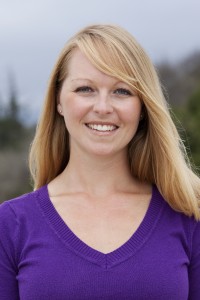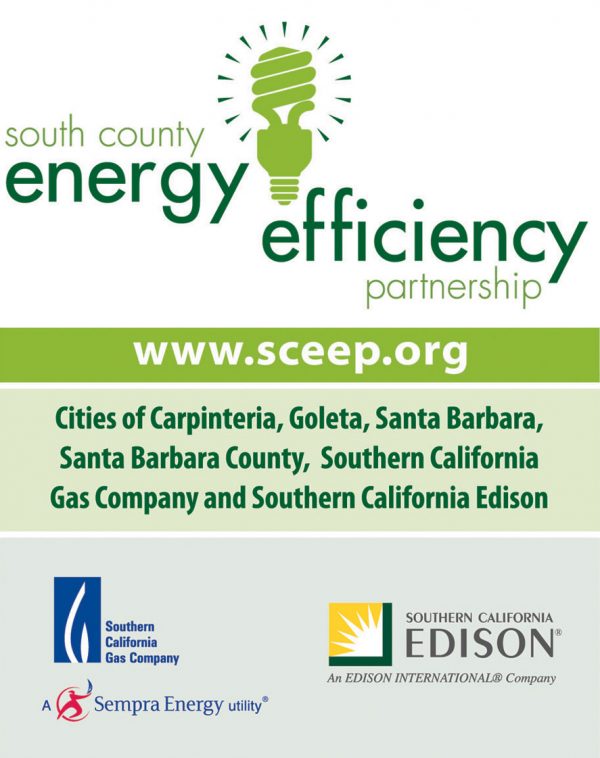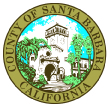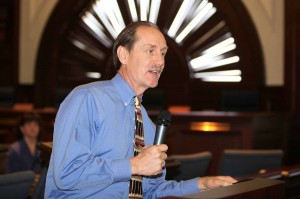Collaborative Planning for a Sustainable Future
October 25, 2012
Detailed Schedule Below
Loma Pelona Conference Center, Manzanita Village, UCSB (Directions Below)
The Central Coast Sustainability Summit is organized in partnership between the Cities of Goleta, Santa Barbara, Carpinteria, the County of Santa Barbara, the Community Environmental Council, and UCSB. The summit will bring together local municipalities and community organizations to share best practices and discuss common issues in energy, transportation, waste, and water management. From the conference we hope to promote local dialogue and pursue regional sustainability partnerships.
Sponsors:
|
The South County Energy Efficiency Partnership (SCEEP) is a partnership of Southern California Edison, Southern California Gas Company, the cities of Carpinteria, Goleta, Santa Barbara, and the County of Santa Barbara. SCEEP seeks to make Santa Barbara’s South County a progressive leader in energy efficiency. Through local outreach events and educational resources, SCEEP provides real solutions to reducing energy use in homes and businesses. Visit SCEEP.org for more information and to learn about how you can save energy, save money, and help protect the environment. |
|
MarBorg Industries is a leader in the community and has made the process of waste collection and diversion simple, streamlined, and environmentally beneficial. Through their well-established programs and services, MarBorg Industries is able to focus on increasing efficiency and reducing harmful impacts on the environment. Their proven ability to promote change begins at the heart of their organization and is evident in improvements made to their corporate headquarters, equipment, and services. |
|
UCSB Sustainability Program |
|
County of Santa Barbara Public Works Department |
Conference Goals:
- Promote Best Practices seeking partnerships or collaborations with other local agencies
- Encourage dialogue between sustainability focus areas (i.e. bridge discussion between energy, transportation, waste, water management……)
- Support the university to fulfill its role as a resource to the community through sharing research, student engagement, and institutional action.
- Network and build relationships with counterparts to learn from local programs, collaboratively address complex environmental issues in our region and consider pool resources resulting in cost savings.
Focus Topics:
Last year’s Summit was a tremendous success in sharing best practices and building relationships. We hope that this year’s Summit will build on those relationships and be a launching point for new multi-jurisdictional collaborations between local government agencies, non-profit organizations, campuses, and private industry. To support this goal, the Summit Planning Committee has selected two focus topics that attendees can learn about during the event and engage with afterwards. These focus topics will be integrated through the opening keynote presentations, world café (an interactive activity to encourage dialogue), and the closing event. Through the summit, we will begin the critical conversations to determine the best way to create new solutions in the area of the focus topics.
We hope for a more in depth conversation post-summit and the development of a recommended plan of action. Most attendees will of course, need to consult with their institution after the event to determine the way in which and degree to which they will engage with the topics. Below are descriptions of the two focus topics.
Renewable Energy
Santa Barbara County could be almost entirely powered by renewable energy. Greater adoption of renewable sources of energy would build the local economy, reduce greenhouse gas emissions, and lower our dependency on fossil fuels like oil, coal, and natural gas. This topic will cover potential actions for anyone present at the summit to build support for renewable energy and move the community toward greater adoption. Potential topics include permitting, group purchasing, community choice aggregation, and pilot projects.
When people speak about waste, the discussion generally focuses on reuse and recycling. A greater emphasis needs to be placed on “closing the loop” by encouraging businesses to sell products containing recycled-content and to promote the purchase of such products by consumers. Further, manufacturers need to adopt the philosophy of “product stewardship,” whereby all parties (i.e. consumers, governmental agencies, manufacturers) involved in the lifecycle of a product share the responsibility of reducing its health and environmental impacts with manufacturers bearing the primary financial responsibility.
Schedule at a Glance
| 8:00am-8:30am | Registration | ||
| 8:30am-9:15am | Opening Keynote | ||
| Welcoming Remarks | |||
 Heidi Sanborn, Executive Director, California Product Stewardship Council (CPSC) Heidi Sanborn, Executive Director, California Product Stewardship Council (CPSC)
Heidi has been a leader in the solid waste industry in California for 22 years, working with industry, government and the public to reduce waste, improve product design and recyclability, and implement cost-effective policies which protect the health of our communities. Collaborating with local government leaders, Heidi founded CPSC in 2007 to change the way product waste is funded and managed in California; she has since become a nationally recognized thought leader and driver for innovative product stewardship programs across the country. Learn more… |
|||
 Megan Birney, Energy Manager, Community Environmental Council Megan Birney, Energy Manager, Community Environmental Council
Megan Birney is the Energy Programs Manager for the Community Environmental Council (CEC). Since 2007 Megan has helped Santa Barbara decrease dependence on fossil fuels through energy conservation, energy efficiency, and making the switch to renewable sources of energy. Megan is responsible for advocacy, education and community initiatives associated with building energy efficiency and renewable energy. Her primary goal at CEC is to help consumers adopt practices and technologies to reduce dependence on fossil fuels. Learn more… |
|||
| 9:30am-10:30am | World Café on Multi-jurisdictional Partnerships | ||
| 10:45am-12pm | Concurrent Sessions A | ||
| Long Range Planning | Civic Engagement | Green Business | |
| The Integration of Transportation, Housing, and Land Use Planning | Rebuilding the Environmental Movement: Volunteer and community Engagement | Green Business Program of Santa Barbara County | |
| Sea Level Rise Projections and Adaptations for Coastal Santa Barbara and UC Santa Barbara | Tapping into College Students | UCSB Housing and Residential Services | |
|
City of Santa Barbara Climate Action Plan |
How students can support businesses to be certified | ||
| 12:00pm-1:15pm | Lunch | ||
| 1:15pm-2:30pm | Concurrent Sessions B | ||
| Collaborating for Water Efficiency in Santa Barbara County | Plug in Central Coast – Electric Vehicle Readiness Plan, Public Charging, and Future Initiatives | Best Practices in Renewable Energy | |
| Santa Barbara County Water Agency | EV Readiness Plan: Collaborative process & funding and EVSE deployment | County of Santa Barbara’s Solar Projects | |
| City of Santa Barbara | The cost of municipal EV charging, rate setting, and implementation (City of Santa Barbara) | Collecting Biogas | |
| Goleta Water District | C5 and Air Resources Board CAFCP SB Hydrogen Task Force | Fuel Cells | |
| 2:45pm-3:30pm | Closing Keynote | ||
| Rick Cole, Former City Manager of Ventura
Cole is widely cited as an urban policy expert and was selected by Governing Magazine as one of its 2006 Public Officials of the Year. The Los Angeles Times has called him “one of Southern California’s most visionary planning thinkers. |
|||
| 3:45pm-5:00pm | Career Panel for Students | ||
Registration
Due to limited space, attendance is primarily invitation-only however, please let us know if you or your organization would like to be included in the invitation list. Invitations have started to be sent out and the registration link is in the invitation letter. The contact for invitations and registration is Katie Maynard, Summit Manager, (kmaynard@geog.ucsb.edu, 805-448-5111).
Directions and Map
If you are using Goggle Maps, please use the address “Loma Pelona, Isla Vista, CA” for your directions.
Campus Map Highlighting the location of the workshop and parking.
Traveling North on the U.S. 101 Freeway:
Exit the 101 freeway at the Airport / UCSB (Route 217) off-ramp (approximately eight miles north of Santa Barbara) and proceed through the Henley Gate at the east campus entrance. Veer right onto Mesa Road and continue through two traffic signals. At the third traffic signal (where you are facing the Recreation Center) turn left. Veer right at the Bus loop. Continue along the road until you see Parking lot 22 to your left. This Campus Map will illustrate the location of the parking and the Loma Pelona conference center. A permit must be displayed on the dashboard of your vehicle while on-campus.
Traveling South on the U.S. 101 Freeway:
Exit the 101 Freeway at the Storke Road / Glen Annie Road (Exit 108) off-ramp (approximately 12 miles north of Santa Barbara). Turn right onto Storke Road and continue to El Colegio Road. Turn left onto El Colegio Road and proceed to Ocean Road. Turn right onto Ocean Road and continue along the road until you see Parking lot 22 to your left. This Campus Map will illustrate the location of the parking and the Loma Pelona conference center. A permit must be displayed on the dashboard of your vehicle while on-campus.




